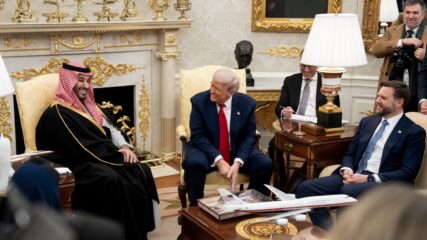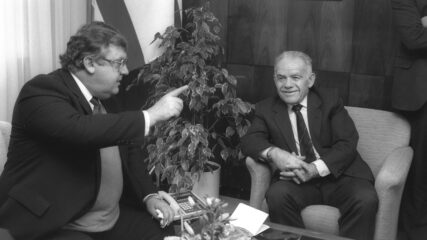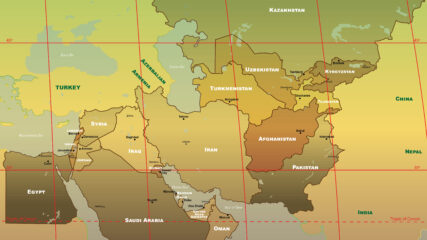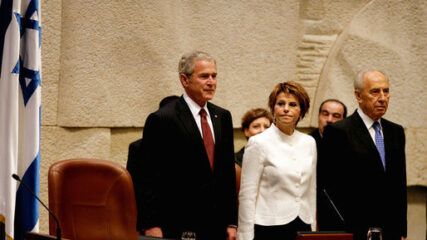November 17, 2025
Source: https://www.un.org/en/media/accreditation/pdf/SCRes3.pdf
The U.N. Security Council voted 13-0 on November 17, 2025, to adopt a U.S.-drafted resolution endorsing the 20-point Trump peace plan to end the Hamas-Israel war. Joining the United States in voting for the resolution were Algeria, Denmark, France, Greece, Guyana, Pakistan, Panama, Sierra Leone, Slovenia, Somalia, South Korea and the United Kingdom. China and Russia abstained.
United Nations Security Council Resolution 2803 is the most detailed U.N. blueprint for resolving differences between Palestinian Arabs and Israeli Jews since the U.N. recommended partitioning Mandatory Palestine into Arab and Jewish states with an economic union in U.N. General Assembly Resolution 181 in November 1947.
While the earlier resolution is highly detailed with respect to maps, borders and institutions in the partitioned areas for two states, the 2025 resolution details the evolution of governance for a limited Palestinian area, the Gaza Strip. Neither the 1978 Camp David Accords nor the 1993 Oslo Accords, both of which addressed Palestinian autonomy, included the quantity of prescriptive detail in Resolution 2803. Of course, having more detail does not guarantee adherence by the Israelis or Palestinians.
Resolution 2803 focuses on disarming Hamas, stabilizing the ceasefire, providing food and other humanitarian aid, reconstructing Gaza’s housing and other infrastructure, training a Palestinian technocratic administration, and maintaining Israeli security. In contrast to the 1947 resolution’s call for an Arab state (rejected by Palestinian Arab leaders and Arab neighbors), the 2025 plan essentially endorses a trusteeship over a small piece of the Arab state that could have been established under Resolution 181. The components of the trusteeship are to include the oversight of a Board of Peace, headed by President Donald Trump, and an International Stabilization Force (ISF) authorized through the end of 2027 and made up of an undisclosed number of military personnel from unspecified countries without a clear mandate on whether to engage, arrest or disarm Hamas fighters and bureaucrats or merely to monitor and report violations.
A key to the ISF is whether it is able and willing to enforce peace. For the ISF to be even marginally successful, Arab states will have to participate in the highly uncomfortable act of disarming Hamas members.
Resolution 2803 says nothing about changing or maintaining Palestinian governance in the West Bank. Beyond references in the appended Gaza peace plan, it says nothing about the establishment of a Palestinian state in the Gaza Strip or anywhere else west of the Jordan River. And it says nothing about Israeli withdrawal from the 53% of the Gaza Strip it now controls.
Hamas vehemently opposes Resolution 2803 and the ISF, recognizing that its independence to fight Israel and its ability to influence the postwar Palestinian administration will be severely curtailed or eliminated. “Assigning the international force with tasks and roles inside the Gaza Strip, including disarming the resistance,” Hamas said in its official response, “strips it of its neutrality, and turns it into a party to the conflict in favor of the occupation.”
The Palestinian Authority, on the other hand, welcomes the unfolding detail in the resolution, at least in part because it is named as a participating administrator in Gaza’s future. The PA “renewed its affirmation of its readiness to assume its full responsibilities in the Gaza Strip, within the framework of the unity of land, people, and institutions, considering the Strip an integral part of the State of Palestine.”
Before the war, the PA and Hamas were at dreadful odds about controlling Palestinian politics. With the bureaucratic birth of the ISF, the PA seeks to ride the operational coattails of the resolution, while Hamas gasps for air. Intended or not, the resolution further divides the dysfunctional Palestinian Arab community, a situation that does not displease the Israeli government.
Resolution 2803 provides a pathway to stability in the Gaza Strip; it is not a road map to a full Palestinian-Israeli settlement of their differences while neither side trusts the other’s intentions. But if fulfilled, the resolution offers a chance for less violence in the Palestinian-Israeli relationship.
In terms of the U.N. history of unfolding a political process aimed at moving the Arab-Israeli conflict along a path toward peace, Resolution 2803 sets a precedent. In outlining a path to significantly reduce Palestinian-Israeli tensions, it does more than the armistice agreements that ended the 1948-49 war; U.N. Security Council Resolution 242 of 1967, which introduced the imprecise concept of exchanging land for peace; U.N. Security Council Resolution 338, which called for “negotiations between the parties” after the October 1973 war; or any of the other resolutions calling for a two-state solution.
Bottom line: The resolution, no matter how nobly intended, cannot force any of the Palestinian factions or the Israeli government to give up long-term objectives. Hamas and other Palestinians want no Israel. And most Israelis do not want to cede any territory, lest their security be threatened as happened after the withdrawals from Lebanon in 2000, which saw Hezbollah evolve into a dominant military force on Israel’s northern border, and from Gaza in 2005, which saw Hamas seize control by mid-2007 and evolve a highly effective autocratic enclave that went to war with Israel five times from 2008 to 2025.
— Ken Stein, November 18, 2025
Read Resolution 2803 in a Printable PDFResolution 2803 (2025)
Adopted by the Security Council at its 10046th meeting, on 17 November 2025
The Security Council,
Welcoming the Comprehensive Plan to End the Gaza Conflict of 29 September 2025 (“Comprehensive Plan”) (annex 1 to this resolution), and applauding the states that have signed, accepted, or endorsed it, and further welcoming the historic Trump Declaration for Enduring Peace and Prosperity of 13 October 2025 and the constructive role played by the United States of America, the State of Qatar, the Arab Republic of Egypt, and the Republic of Türkiye, in having facilitated the ceasefire in the Gaza Strip,
Determining that the situation in the Gaza Strip threatens the regional peace and the security of neighboring states and noting prior relevant Security Council resolutions relating to the situation in the Middle East, including the Palestinian question,
1. Endorses the Comprehensive Plan, acknowledges the parties have accepted it, and calls on all parties to implement it in its entirety, including maintenance of the ceasefire, in good faith and without delay;
2. Welcomes the establishment of the Board of Peace (BoP) as a transitional administration with international legal personality that will set the framework, and coordinate funding for, the redevelopment of Gaza pursuant to the Comprehensive Plan, and in a manner consistent with relevant international legal principles, until such time as the Palestinian Authority (PA) has satisfactorily completed its reform program, as outlined in various proposals, including President Trump’s peace plan in 2020 and the Saudi-French Proposal, and can securely and effectively take back control of Gaza. After the PA reform program is faithfully carried out and Gaza redevelopment has advanced, the conditions may finally be in place for a credible pathway to Palestinian self-determination and statehood. The United States will establish a dialogue between Israel and the Palestinians to agree on a political horizon for peaceful and prosperous coexistence;
3. Underscores the importance of the full resumption of humanitarian aid in cooperation with the BoP into the Gaza Strip in a manner consistent with relevant international legal principles and through cooperating organizations, including the United Nations, the International Committee of the Red Cross, and the Red Crescent, and ensuring such aid is used solely for peaceful uses and not diverted by armed groups;
4. Authorizes Member States participating in the BoP and the BoP to: (A) enter into such arrangements as may be necessary to achieve the objectives of the Comprehensive Plan, including those addressing privileges and immunities of personnel of the force established in paragraph 7 below; and (B) establish operational entities with, as necessary, international legal personality and transactional authorities for the performance of its functions, including: (1) the implementation of a transitional governance administration, including the supervising and supporting of a Palestinian technocratic, apolitical committee of competent Palestinians from the Strip, as championed by the Arab League, which shall be responsible for day-to-day operations of Gaza’s civil service and administration; (2) the reconstruction of Gaza and of economic recovery programs; (3) the coordination and supporting of and delivery of public services and humanitarian assistance in Gaza; (4) any measures to facilitate the movement of persons in and out of Gaza, in a manner consistent with the Comprehensive Plan; and (5) any such additional tasks as may be necessary to support and implement the Comprehensive Plan;
5. Understands that the operational entities referred to in paragraph 4 above will operate under the transitional authority and oversight of the BoP and are to be funded through voluntary contributions from donors and BoP funding vehicles and governments;
6. Calls upon the World Bank and other financial institutions to facilitate and provide financial resources to support the reconstruction and development of Gaza, including through the establishment of a dedicated trust fund for this purpose and governed by donors;
7. Authorizes Member States working with the BoP and the BoP to establish a temporary International Stabilization Force (ISF) in Gaza to deploy under unified command acceptable to the BoP, with forces contributed by participating States, in close consultation and cooperation with the Arab Republic of Egypt and the State of Israel, and to use all necessary measures to carry out its mandate consistent with international law, including international humanitarian law. The ISF shall work with Israel and Egypt, without prejudice to their existing agreements, along with the newly trained and vetted Palestinian police force, to help secure border areas; stabilize the security environment in Gaza by ensuring the process of demilitarizing the Gaza Strip, including the destruction and prevention of rebuilding of the military, terror, and offensive infrastructure, as well as the permanent decommissioning of weapons from non-state armed groups; protect civilians, including humanitarian operations; train and provide support to the vetted Palestinian police forces; coordinate with relevant States to secure humanitarian corridors; and undertake such additional tasks as may be necessary in support of the Comprehensive Plan. As the ISF establishes control and stability, the Israel Defense Forces (IDF) will withdraw from the Gaza Strip based on standards, milestones, and timeframes linked to demilitarization that will be agreed between the IDF, ISF, the guarantors, and the United States, save for a security perimeter presence that will remain until Gaza is properly secure from any resurgent terror threat. The ISF shall, (A) assist the BoP in monitoring the implementation of the ceasefire in Gaza, and enter into such arrangements as may be necessary to achieve the objectives of the Comprehensive Plan; and (B) operate under the strategic guidance of the BoP and will be funded through voluntary contributions from donors and BoP funding vehicles and governments;
8. Decides the BoP and international civil and security presences authorized by this resolution shall remain authorized until Dec. 31, 2027, subject to further action by the Council, and any further reauthorization of the ISF be in full cooperation and coordination with Egypt and Israel and other Member States continuing to work with the ISF;
9. Calls upon Member States and international organizations to work with the BoP to identify opportunities to contribute personnel, equipment, and financial resources to its operating entities and the ISF, to provide technical assistance to its operating entities and the ISF, and to give full recognition to its acts and documents;
10. Requests the BoP provide a written report on progress related to the above to the UN Security Council every six months;
11. Decides to remain seized of the matter.
ANNEX 1 — President Donald J. Trump’s Comprehensive Plan to End the Gaza Conflict
1. Gaza will be a deradicalized terror-free zone that does not pose a threat to its neighbors.
2. Gaza will be redeveloped for the benefit of the people of Gaza, who have suffered more than enough.
3. If both sides agree to this proposal, the war will immediately end. Israeli forces will withdraw to the agreed upon line to prepare for a hostage release. During this time, all military operations, including aerial and artillery bombardment, will be suspended, and battle lines will remain frozen until conditions are met for the complete staged withdrawal.
4. Within 72 hours of Israel publicly accepting this agreement, all hostages, alive and deceased, will be returned.
5. Once all hostages are released, Israel will release 250 life sentence prisoners plus 1700 Gazans who were detained after October 7th, 2023, including all women and children detained in that context. For every Israeli hostage whose remains are released, Israel will release the remains of 15 deceased Gazans.
6. Once all hostages are returned, Hamas members who commit to peaceful co-existence and to decommission their weapons will be given amnesty. Members of Hamas who wish to leave Gaza will be provided safe passage to receiving countries.
7. Upon acceptance of this agreement, full aid will be immediately sent into the Gaza Strip. At a minimum, aid quantities will be consistent with what was included in the January 19, 2025, agreement regarding humanitarian aid, including rehabilitation of infrastructure (water, electricity, sewage), rehabilitation of hospitals and bakeries, and entry of necessary equipment to remove rubble and open roads.
8. Entry of distribution and aid in the Gaza Strip will proceed without interference from the two parties through the United Nations and its agencies, and the Red Crescent, in addition to other international institutions not associated in any manner with either party. Opening the Rafah crossing in both directions will be subject to the same mechanism implemented under the January 19, 2025, agreement.
9. Gaza will be governed under the temporary transitional governance of a technocratic, apolitical Palestinian committee, responsible for delivering the day-to-day running of public services and municipalities for the people in Gaza. This committee will be made up of qualified Palestinians and international experts, with oversight and supervision by a new international transitional body, the “Board of Peace,” which will be headed and chaired by President Donald J. Trump, with other members and heads of State to be announced, including Former Prime Minister Tony Blair. This body will set the framework and handle the funding for the redevelopment of Gaza until such time as the Palestinian Authority has completed its reform program, as outlined in various proposals, including President Trump’s peace plan in 2020 and the Saudi-French proposal, and can securely and effectively take back control of Gaza. This body will call on best international standards to create modern and efficient governance that serves the people of Gaza and is conducive to attracting investment.
10. A Trump economic development plan to rebuild and energize Gaza will be created by convening a panel of experts who have helped birth some of the thriving modern miracle cities in the Middle East. Many thoughtful investment proposals and exciting development ideas have been crafted by well-meaning international groups, and will be considered to synthesize the security and governance frameworks to attract and facilitate these investments that will create jobs, opportunity, and hope for future Gaza.
11. A special economic zone will be established with preferred tariff and access rates to be negotiated with participating countries.
12. No one will be forced to leave Gaza, and those who wish to leave will be free to do so and free to return. We will encourage people to stay and offer them the opportunity to build a better Gaza.
13. Hamas and other factions agree to not have any role in the governance of Gaza, directly, indirectly, or in any form. All military, terror, and offensive infrastructure, including tunnels and weapon production facilities, will be destroyed and not rebuilt. There will be a process of demilitarization of Gaza under the supervision of independent monitors, which will include placing weapons permanently beyond use through an agreed process of decommissioning, and supported by an internationally funded buy back and reintegration program all verified by the independent monitors. New Gaza will be fully committed to building a prosperous economy and to peaceful coexistence with their neighbors.
14. A guarantee will be provided by regional partners to ensure that Hamas, and the factions, comply with their obligations and that New Gaza poses no threat to its neighbors or its people.
15. The United States will work with Arab and international partners to develop a temporary International Stabilization Force (ISF) to immediately deploy in Gaza. The ISF will train and provide support to vetted Palestinian police forces in Gaza and will consult with Jordan and Egypt, who have extensive experience in this field. This force will be the long-term internal security solution. The ISF will work with Israel and Egypt to help secure border areas, along with newly trained Palestinian police forces. It is critical to prevent munitions from entering Gaza and to facilitate the rapid and secure flow of goods to rebuild and revitalize Gaza. A deconfliction mechanism will be agreed upon by the parties.
16. Israel will not occupy or annex Gaza. As the ISF establishes control and stability, the Israel Defense Forces (IDF) will withdraw based on standards, milestones, and timeframes linked to demilitarization that will be agreed upon between the IDF, ISF, the guarantors, and the United States, with the objective of a secure Gaza that no longer poses a threat to Israel, Egypt, or its citizens. Practically, the IDF will progressively hand over the Gaza territory it occupies to the ISF according to an agreement they will make with the transitional authority until they are withdrawn completely from Gaza, save for a security perimeter presence that will remain until Gaza is properly secure from any resurgent terror threat.
17. In the event Hamas delays or rejects this proposal, the above, including the scaled-up aid operation, will proceed in the terror-free areas handed over from the IDF to the ISF.
18. An interfaith dialogue process will be established based on the values of tolerance and peaceful co-existence to try and change mindsets and narratives of Palestinians and Israelis by emphasizing the benefits that can be derived from peace.
19. While Gaza re-development advances and when the PA reform program is faithfully carried out, the conditions may finally be in place for a credible pathway to Palestinian self-determination and statehood, which we recognize as the aspiration of the Palestinian people.
20. The United States will establish a dialogue between Israel and the Palestinians to agree on a political horizon for peaceful and prosperous co-existence.







